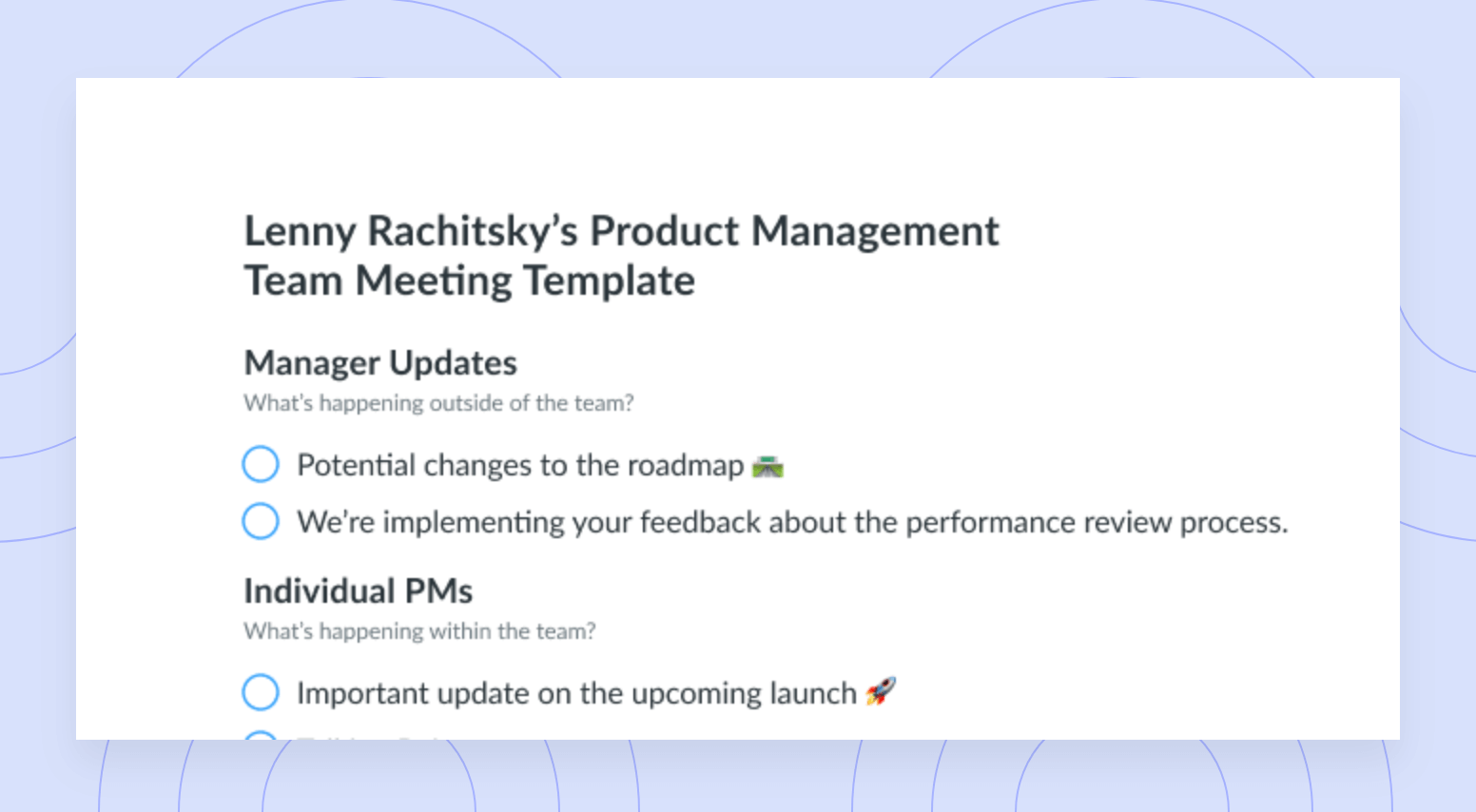
Weekly 1-on-1 Meeting Template
Get this templateHave more productive conversations by asking your direct report to answer these questions prior to the 1-on-1 meeting.


Weekly 1-on-1 overview
What is a weekly 1-on-1 meeting?
A one-on-one (or 1-on-1) meeting is a dedicated space in your calendar that you can leverage to connect with every person who reports to you. Carving out time in your calendar to schedule one-on-ones is imperative as these meetings are likely the only time you’ll get to meet with your employees individually. Weekly one-on-ones can be used to work through problems, discuss roadblocks, provide encouragement, or discuss professional development opportunities.
What should be discussed in a weekly 1-on-1 meeting?
In short, this time should be used to discuss your direct report’s progress while creating a feedback loop that the two of you can leverage to gain insights and improve. Weekly one-on-one meetings provide you with the opportunity to give and receive in-depth feedback that wouldn’t be appropriate to share in a group setting. These meetings can be used to provide feedback, hone in on coaching, and speak to the strengths and weaknesses of each member on your team.
Why are weekly 1-on-1 meetings important?
Weekly one-on-ones help:
- Unblock teammates.
- Learn about team dynamics.
- Discover and proactively address issues.
- Build trust with the people on your team.
- Check-in and follow up on goals and OKRs (objectives and key results).
- Exchange positive and constructive feedback.
- Coach employees and prioritize professional development.
- Provide a safe space to ask questions and provide feedback about company initiatives.
How long should a weekly 1-on-1 meeting be?
When determining how long your weekly 1-on-1 meeting should last, it’s best to reference your weekly 1-on-1 meeting agenda. Crafting a thorough meeting agenda with key talking points while factoring in time for questions and relevant discussions will help you determine how much time you need to set aside for your meeting. When crafting your meeting agenda, don’t forget to include sections that build trust and spark meaningful conversations. Your direct reports should feel comfortable speaking up and sharing whatever’s on their mind. In addition to speaking about work, it’s important to use this time to get to know each one of your direct reports on a personal level.
How to use a weekly 1-on-1 meeting agenda template
Leveraging a weekly 1-on-1 meeting agenda template is a quick and easy way to create a deliberate dialogue that unblocks and empowers your direct reports. If you want your direct reports to feel engaged, empowered, and confident, you need to prioritize regular one-on-one meetings. Leveraging our 1-on-1 meeting agenda template will ensure you’re well-equipped and ready to host an effective meeting.
What’s inside this 1-on-1 Meeting Template:
Our weekly 1-on-1 meeting agenda templates make it easier than ever to host meaningful meetings that set the groundwork for future success. Complete with three key sections—personal stuff, questions and answers, and rocks—this template encompasses everything you need to take your one-on-one meetings up a notch.
1⭐️Personal Stuff (5 minutes)
Let’s kick off the meeting with some personal updates and exciting news!
This section of the meeting should be used to talk about anything but work. It’s best to cover the personal stuff before the meeting starts; this way you can get down to business as soon as the meeting kicks off. Alternatively, you can wrap up your meeting by checking in and chatting about each other’s personal lives. It’s important that you carve out time to get to know your direct reports on a personal level, and this is the perfect time to do so.
2 💬 Questions and Answers
Notify the direct report beforehand to prepare these questions in advance to present their answers.
- What is your state of mind?
- What was the highlight of last week?
- What happened unexpectedly?
- What’s something I can do to make your week better?
Chances are your direct reports don’t often have the opportunity to chat with you one-on-one. As a result, they may have tons of questions they’ve been meaning to ask you. Allocating a section of your meeting to questions and answers (Q&A) will ensure your direct reports have the opportunity to ask anything that’s on their mind. It’s important to let your direct reports know that you’ll be hosting a Q&A so they have time to prepare their questions.
This is also a great time for you to ask questions that will allow you to gain a more in-depth understanding of your direct report’s progress and current state. Questions include, but aren’t limited to: What is your current state of mind? What was the highlight of last week? Was there anything that happened last week that was unexpected? What’s something that I can do to make your week better?
3🤘Rocks (90-day goals)
How can I help you crush your 90-day goals💪.
Long-term goal planning is crucial for success, so it’s important to allocate a section of your weekly 1-on-1 meeting agenda to long-term planning and success. During this time, it’s important that you review your direct report’s long-term goals so you can learn how to best support them as they work towards their 90-day goals.















